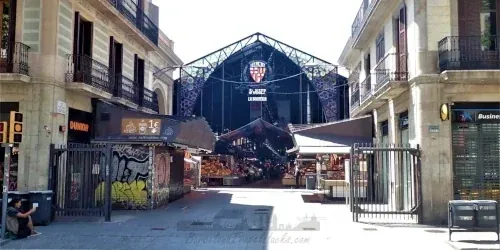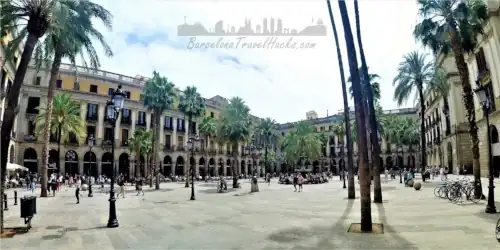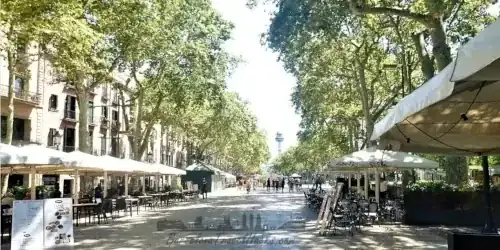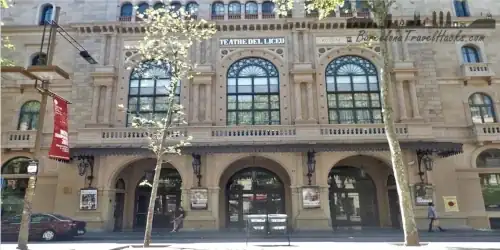Please sign in with Google to view the map.
Sign in with GooglePalau Güell: Gaudí’s Castle-Style Mansion in Las Ramblas
Visit Palau Güell, Gaudí’s medieval-style mansion in Las Ramblas. Explore all floors of this UNESCO-listed museum. Tickets, hours, and tour info available
About Palau Güell: Gaudí’s Medieval Masterpiece in Las Ramblas
Palau Güell, Barcelona is a stunning example of early Gaudí architecture located at the junction of La Rambla and Nou de la Rambla. Built between 1886 and 1890 for the influential industrialist and patron of the arts Eusebi Güell, this Gaudí palace was designed as a luxurious urban residence and is now a popular museum and UNESCO World Heritage Site.
The building’s dramatic façade evokes a medieval castle, with parabolic arches and ornate iron gates resembling portcullises. Above the entrance sits a dragon—an homage to Sant Jordi, Catalonia’s patron saint. This mythical motif is a recurring theme in Gaudí’s work and adds to the building’s symbolic richness.
Gaudí’s vertical design cleverly maximizes space on a narrow footprint of just 18 by 22 meters. The structure follows a castle-like layout, with each level serving a distinct purpose. From the stables and servant quarters below to the noble reception rooms and private family spaces above, every detail reflects Gaudí’s mastery of form and function.
Palau Güell was Gaudí’s first major commission from Eusebi Güell and was originally connected to the family’s Las Ramblas home via a secret passage—now sealed but partially visible during your visit. The building also showcases Gaudí’s holistic design approach, with custom furniture and fixtures throughout.
Stylistically, Palau Güell shares Oriental and Arabian influences with Casa Vicens, Gaudí’s first noble house in Gracia. Both homes feature boxy, geometric structures that contrast with the flowing lines of his later works in Passeig de Gràcia.
Recognized as a Palau Güell UNESCO site since 1984, the building underwent extensive restoration between 2004 and 2011 to preserve its structural integrity and artistic legacy. Today, it stands as one of the most visually intriguing and historically rich attractions in Barcelona.
photo Gallery of Palau Güell: Architecture, Art, and Atmosphere
Click on any of the 58 images to open full screen gallery player. Note that viewing images is subject to our Fair Use Policy.
Plan Your Visit to Palau Güell & What to Expect
Palau Güell is fully open to the public as a museum, offering a complete experience across all floors. It is the only Gaudí house in Las Ramblas, making it a truly unique architectural gem in the heart of Barcelona. Unlike Casa Batlló, Casa Milà (La Pedrera), and Torre Bellesguard, which only allow access to one floor and the rooftop terrace, a Palau Güell visit covers the entire house. Even better, the Palau Güell ticket price is typically a third—or even less—of what Casa Batlló and Casa Milà charge, offering excellent value for money for architecture lovers and cultural explorers alike.
Is Palau Güell Worth a Visit?
Absolutely! If you're wondering whether to visit Palau Güell Barcelona, the answer is a resounding yes. It’s one of the few Gaudí buildings where you can explore every level—from basement to rooftop. With its rich history, immersive layout, and affordable entry, it’s a top pick for Gaudí on a budget.
We recommend Palau Güell, Torre Bellesguard, and Casa Vicens as the best value-for-money Gaudí attractions. Each offers unique architecture, rich history, and visual splendor.
What is inside Palau Güell?
- Basement: Originally designed as stables for the Güell family’s horses, this level features a spiral ramp from street level and also housed the servants’ quarters. The dim lighting and stonework evoke the building’s functional origins.
- Ground Floor: Served as the carriage drop-off point, with direct access to the staircase leading to the noble floor. The parabolic arches and ornate iron gates here are among the most photographed features.
- First Floor (Noble Floor): Includes a luminous reception hall, smoking room, lounge with a pipe organ, and side rooms like the dining room and music salon—spaces designed for entertaining in aristocratic style.
- Second Floor: The family’s private quarters, with bedrooms and bathrooms arranged around a double-height lounge. Peep holes allowed the Güells to discreetly observe guests and adjust their attire accordingly.
- Attic: Housed additional servant quarters and storage. Though modest, it reflects Gaudí’s attention to detail in every corner.
- Rooftop Terrace: Features twenty colorful chimneys decorated with trencadís mosaic tiles and a central spire with skylights. The Sant Jordi dragon-shaped weather vane crowns the terrace with symbolic flair.
Palau Güell Opening Hours
- Summer (April 1 – September 30): 10:00h to 20:00h daily, except Mondays.
- Winter (October 1 – March 31): 10:00h to 17:30h daily, except Mondays.
- The ticket office closes at 19:00h in summer and 16:30h in winter.
Other Gaudí Works
For Gaudí’s most iconic masterpiece, visit La Sagrada Família.
To see the house where Gaudí lived, head to Parc Güell and consider a combined Gaudí House Museum ticket.
Pair Casa Batlló with Casa Milà / La Pedrera—they’re just 500 meters apart in Passeig de Gràcia.
Explore more Gaudí gems like Casa Vicens in the Gracia Neighbourhood and Torre Bellesguard in Sant Gervasi.
Each of these Gaudí wonders offers a distinct style and story, making them must-see stops for architecture lovers and cultural explorers alike.
Accessibility & What to Bring
Palau Güell is partially accessible for visitors with mobility needs. An elevator connects most floors, making it suitable for wheelchair users. However, please note that the rooftop terrace is only accessible via stairs. A wheelchair loan service is available for guests who require a chair narrower than the 60 cm elevator door.
The basement level, originally designed for horses, is accessible via a spiral ramp. While atmospheric and historically significant, this ramp may not be suitable for wheelchairs due to its steep incline and curvature.
Families with small children can request a baby carrier, as pushchairs are not permitted throughout the tour route.
For security and comfort, large bags, rucksacks, and oversized items are not allowed inside the building. Please bring only small bags that can be easily carried.
There are no bicycle anchorage points outside Palau Güell, and bike theft is common in this area. We recommend using public transport or walking from nearby metro stations.
Tip: The audio guide is included in the ticket price and available in multiple languages. However, it does not come with headphones. For the best experience, bring your own 3.5mm jack headphones—one of our top Palau Güell audio guide tips.
Palau Güell Tickets
Plan to spend around 90 minutes exploring the interior. Note that the ticket office is located in the archway to the left of the main entrance—not inside the building itself.
While you can buy tickets on-site with a small surcharge, we strongly recommend purchasing Palau Güell skip-the-line tickets online to avoid queues and ensure availability, especially during peak seasons.
Getting to Palau Güell
Address: Carrer Nou de la Rambla 3–5, Barcelona, 08001
Palau Güell is centrally located just off La Rambla, making it easily accessible by public transport. The nearest TMB Metro stations are Drassanes and Liceu, both on the Green Line (L3). From either station, it’s a short walk to the entrance.
For the best value on public transport, use a T-Casual card for multiple journeys or opt for the Hola Barcelona Travel Card for unlimited travel during your stay.
Due to limited parking and high bicycle theft risk in the area, we recommend arriving on foot or by metro.
Map for Palau Güell
Weather for Palau Güell
Where to stay near to Palau Güell
Nearby Attractions to Palau Güell
 METRO
METRO
La Boquería Market: Barcelona’s Historic Food Haven on La Rambla
La Boquería: Barcelona’s oldest and most iconic fresh produc food market. Sizzling tapas, and vibrant stalls nestled off La Rambla in the heart of the Raval district
Read more >
 METRO
METRO
Plaça Reial: Gaudí Lamp Posts & Nightlife in Barcelona
Historic square in the Gothic Quarter with Gaudí lamp posts, lively bars, restaurants, and the Font de les Tres Gràcies fountain. Built on a former monastery site
Read more >
 METRO
METRO
Las Ramblas: Living Statues, Artisan Markets & Historic Fountains
Discover Las Ramblas, Barcelona’s iconic pedestrian boulevard with living statues, flower stalls, pop-up artisan markets, mosaics, and historic fountains
Read more >
 METRO
METRO